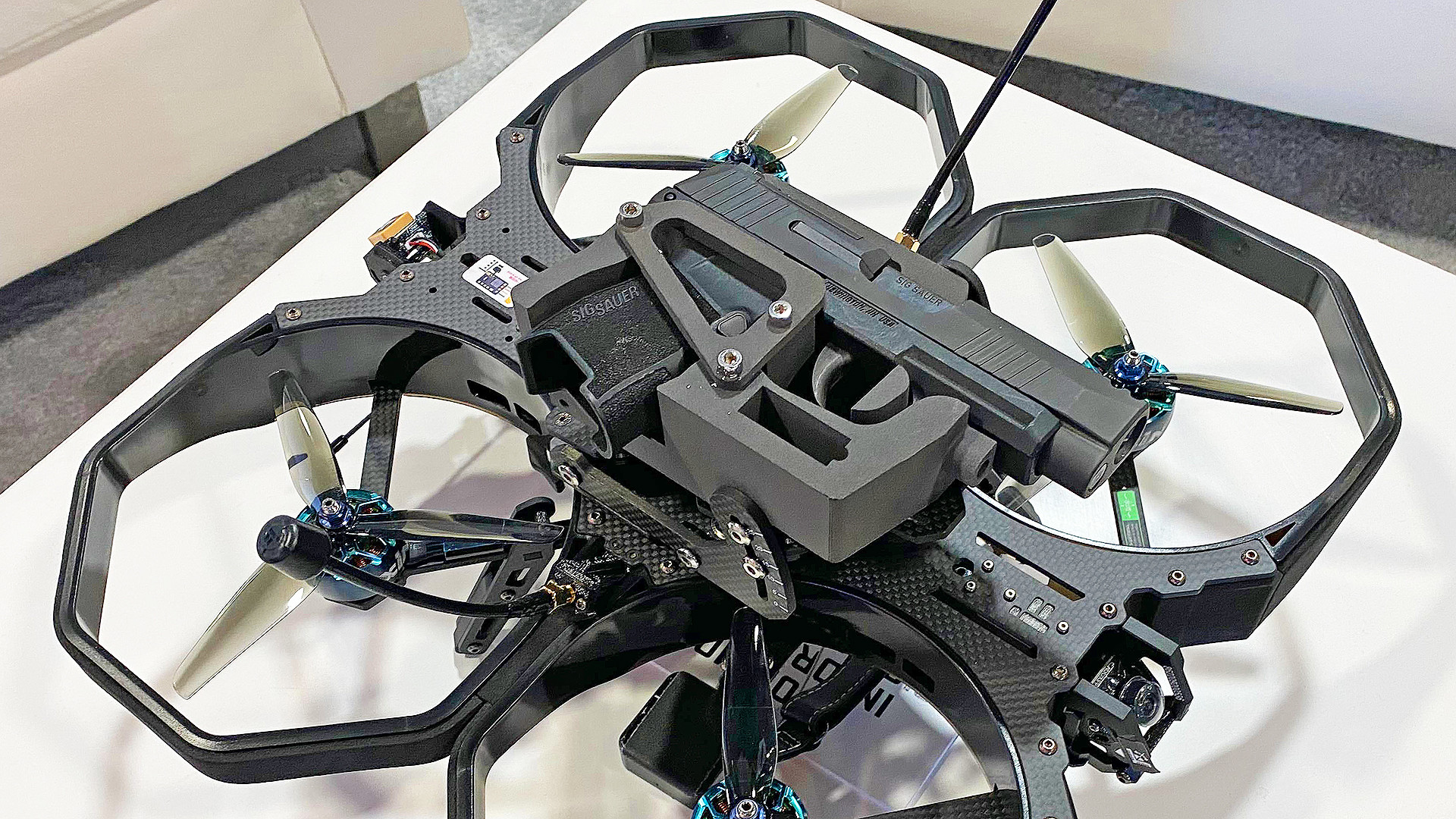Gunmaker Sig Sauer is experimenting with pistol-armed quadcopters that a single person can carry and employ because, as one spokesman has put it, “why wouldn’t we?” While small arms-toting aerial drones are still somewhat oddities, ground systems featuring them that small units, or even a single person, can carry and operate have seen growing interest among military and other security forces. This follows years of small commercially available aerial drones with other kinds of improvised armament becoming ever-increasing threats on and off traditional battlefields, and also presenting some of the biggest tactical development opportunities for state militaries.

Sig Sauer brought two different quadcopters armed with pistols to this year’s iteration of the Association of the U.S. Army’s (AUSA) main annual convention in Washington, D.C., which opened yesterday. Sig Sauer is also the company behind the U.S. Army’s new XM7 rifle and XM250 light machine gun, both in the 6.8x51mm caliber, as well as the 9x19mm Modular Handgun System (MHS) pistols that are now becoming standard across the U.S. military.
Sig Sauer’s Jason St. John talked to War Zone contributor Jamie Hunter on the show floor. When asked why the company paired America’s most popular subcompact pistol, the P365, with a quadcopter drone, St. John said “Why wouldn’t we? The small arms space right now is about the expansion of capability in the combined tech world. Every imaginable aspect of what you could put on a drone. How do you arm a man-portable drone that’s effective? We are in the age of discovery of what’s possible.”

The larger of the two armed quadcopters that Sig Sauer has on display at AUSA this year, pictures of which are seen earlier in this story, has an added mount on top holding an unmodified P365-series pistol with a P365XL slide featuring an integrated compensator that will help to tame muzzle flip. It is not immediately clear what the exact type of drone used in this pairing is, but it is a commercial-off-the-shelf design.
The full P365 line is a series of compact pistols that are marketed heavily, especially in the United States, for everyday personal self-defense, including while being carried concealed. The design is highly modular and versions are available in the 9x19mm and .380 ACP calibers.


The smaller of Sig Sauer’s two armed quadcopter designs, seen below, features a stripped-down, ‘skeletonized,’ and lightened P365 that is mounted underneath instead of on top. The modified Lumenier drone is otherwise similar in general form and function to its larger cousin.
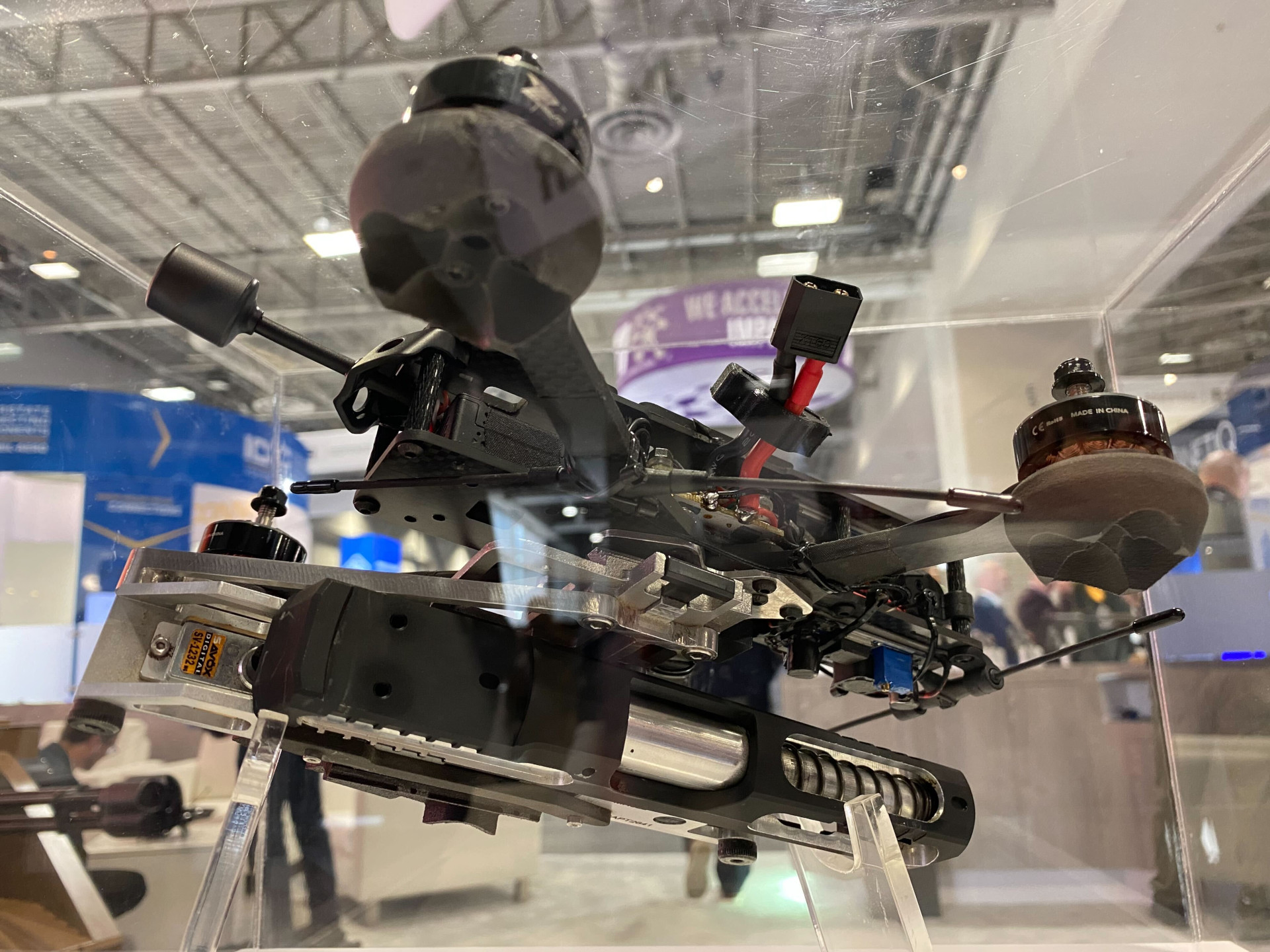
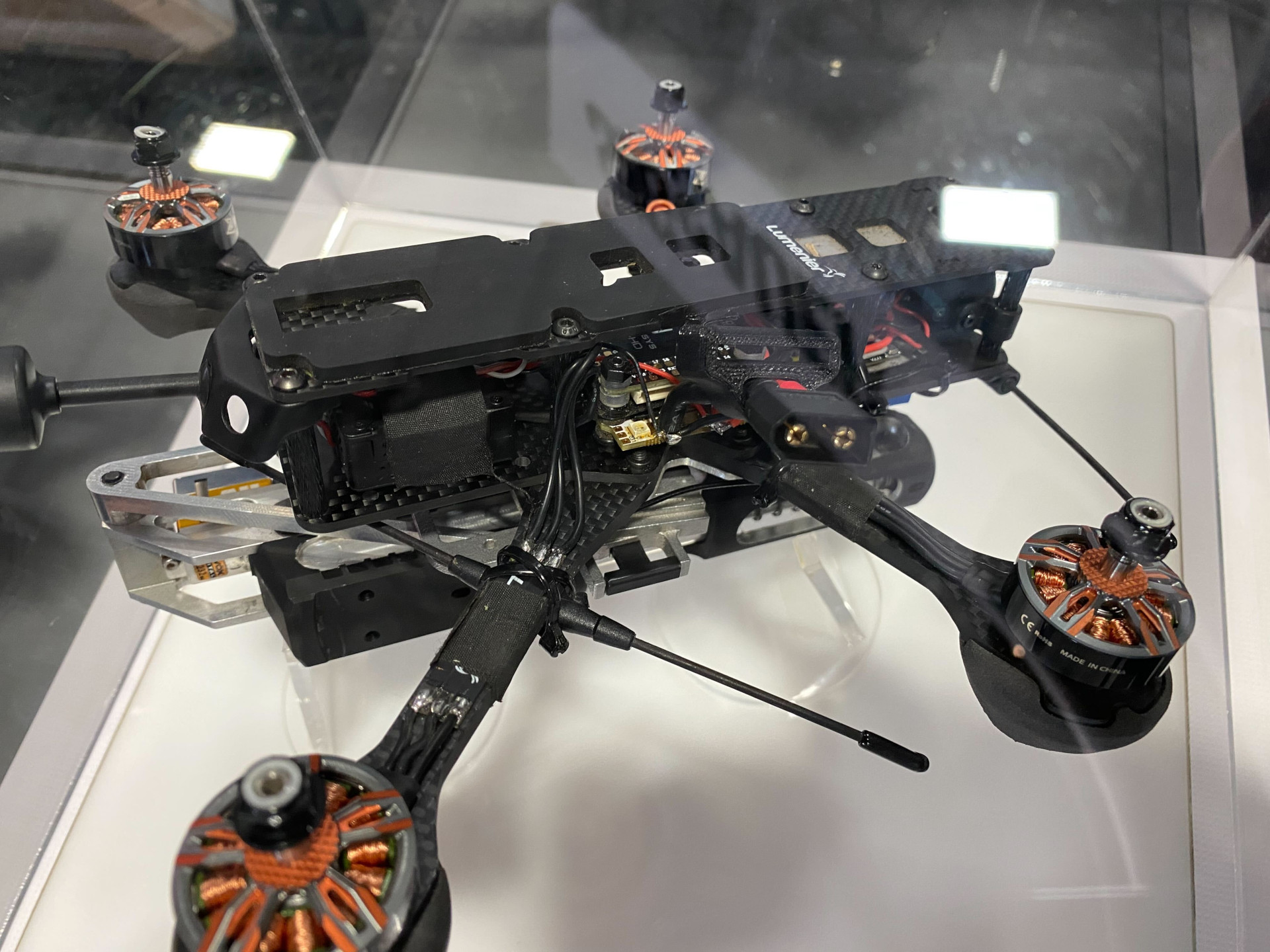
In both cases, there is a mechanism to pull the pistol’s trigger with the help of a servo motor after the operator commands the gun to fire via remote control. The weapon is aimed via the quadcopter’s built-in camera with the help of a laser aiming device.
The recoil of the pistol firing is said to have a negligible impact on the stability of the quadcopter. “We’ve shot it. It works,” Sig Sauer’s St. John told The War Zone.
It is important to note that these are largely experimental designs that Sig Sauer has crafted to help explore what might be possible when it comes to blending the company’s firearms with aerial drones. In addition, the P365 pistol has a relatively limited effective range and commercial-type quadcopters typically cannot fly very long distances away from their operators.
At the same time, Sig Sauer’s St. John did say that unnamed “specific customers have asked us to do it [create weaponized drone concepts].” There are clear potential use cases for these specific designs, as well.
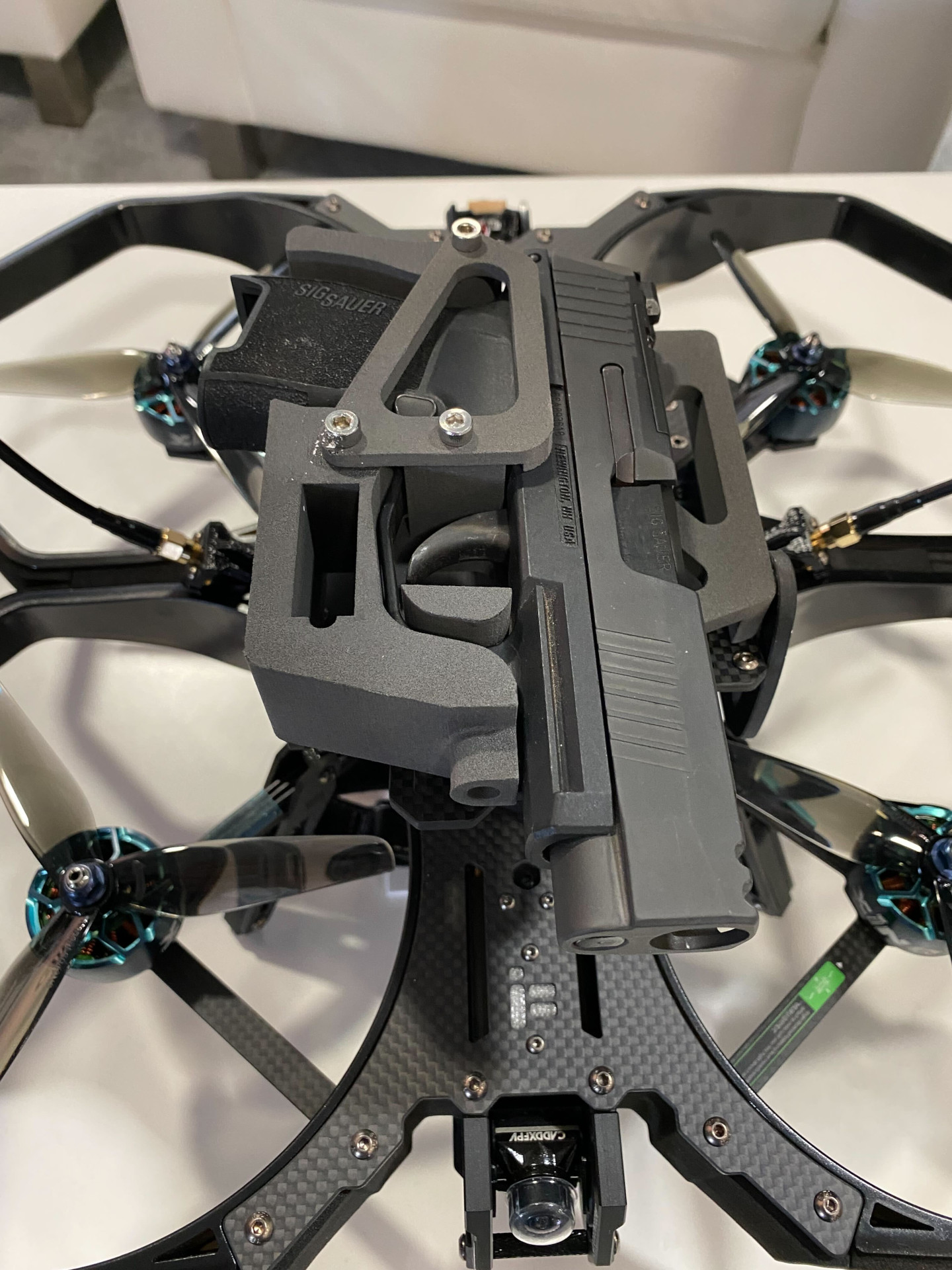
Armed quadcopters could still be used to scout ahead, especially in dense urban environments where it can be difficult to just see around corners or into buildings. They would then have the ability to immediately engage any enemy personnel they might stumble upon. Even with just a pistol, an armed drone like this could offer an additional way to engage enemy personnel behind hard cover, too. On top of all this, the ability of a single person to carry and employ a drone like this would make it a very flexible capability, even if it is very short-ranged overall.
In addition, the combination of pistol and quadcopter could be valuable in hostage rescue and other localized counter-terrorism and law enforcement scenarios. These often occur inside buildings or other confined spaces full of innocent bystanders. A small armed drone might be able to infiltrate into areas where it would be too risky for actual humans to go or even traverse spaces too small for a person to get through at all to approach a target from a different and unexpected vector.
The Dallas Police Department’s use of a small explosive charge delivered by a small robotic ground vehicle to kill a barricaded gunman in 2016 set a precedent for the employment of these kinds of capabilities by law enforcement entities.

The core concept here could be expanded upon, too, to incorporate larger guns onto larger drones offering increased capabilities across greater ranges. This is, of course, not the first time that a quad or hexacopter type drone has been demonstrated, or at least proposed, as a potential firing platform for small arms, including pistols and assault rifles.
Kyle Lamar Myers, an American YouTuber better known as Dimitri Potapov or FPS Russia, drew very real attention to this general concept in a viral video in 2012 featuring a questionable design with what appears to have not even been a real firearm. A more functional homemade creation armed with a pistol infamously got a U.S. teenager in Connecticut arrested back in 2015.


More functional purpose-built designs have since emerged, including the TIKAD from Duke Robotics, seen in the video below. Duke Robotics says this drone can armed with stripped-down versions of the 5.56x45mm M4 carbine and 7.62x51mm SR-25 rifle from Knight’s Armament Company, as well as an M32A1 six-shot 40x46mm grenade launcher.

Small commercial quad and hexacopter uncrewed aerial systems have been weaponized in various other ways over the years, as well, including with the addition of improvised air-droppable munitions. Kamikaze types with explosive warheads that are designed to hit their targets directly are also now commonly seen. These different kinds of weaponized drones are now routinely used around the world on and off traditional battlefields by nation-state militaries, non-state armed groups, and even organized criminal enterprises.
Though they have been real threats, even to large armed forces like the U.S. military, for years now, weaponized drones of these types have gained new attention thanks to their very active use on both sides of the conflict in Ukraine.
Their demonstrated effectiveness in the fighting in that country and elsewhere is also helping push companies to explore offering more robust, purpose-built designs. Israel’s Elbit also now offers a quadcopter-based loitering munition with a high-explosive warhead. Named LANIUS, this system is designed to be able to hunt down enemy personnel with a high degree of autonomy, including inside buildings, as you can read more about here.

As already noted, there is a rapidly growing market space for man-portable uncrewed aerial systems equipped with various types of small arms that companies like Sig Sauer are very interested in capitalizing on.
Arming smaller uncrewed systems with different types of guns is a trend that extends to drones on the ground, too. At AUSA’s show in 2021, Ghost Robotics and SWORD International caused quite a stir when they unveiled a quadrupedal unmanned ground vehicle (Q-UGV), or “robot dog,” armed with a 6.5mm Creedmoor rifle. You can read more about that particular combination here.
Since then, a number of other robot dog designs have emerged armed with small arms, as well as infantry anti-tank rocket launchers.
In addition to the pistol-armed quadcopters, Sig Sauer itself brought a small tracked robot called Mule equipped with a Stone Horse NG3 Gatling-type machine gun chambered to fire the .338 Norma Magnum rifle round to this year’s AUSA event. This design, seen below, reflects another category of small armed UGVs that the U.S. military and others have evaluated over the years.
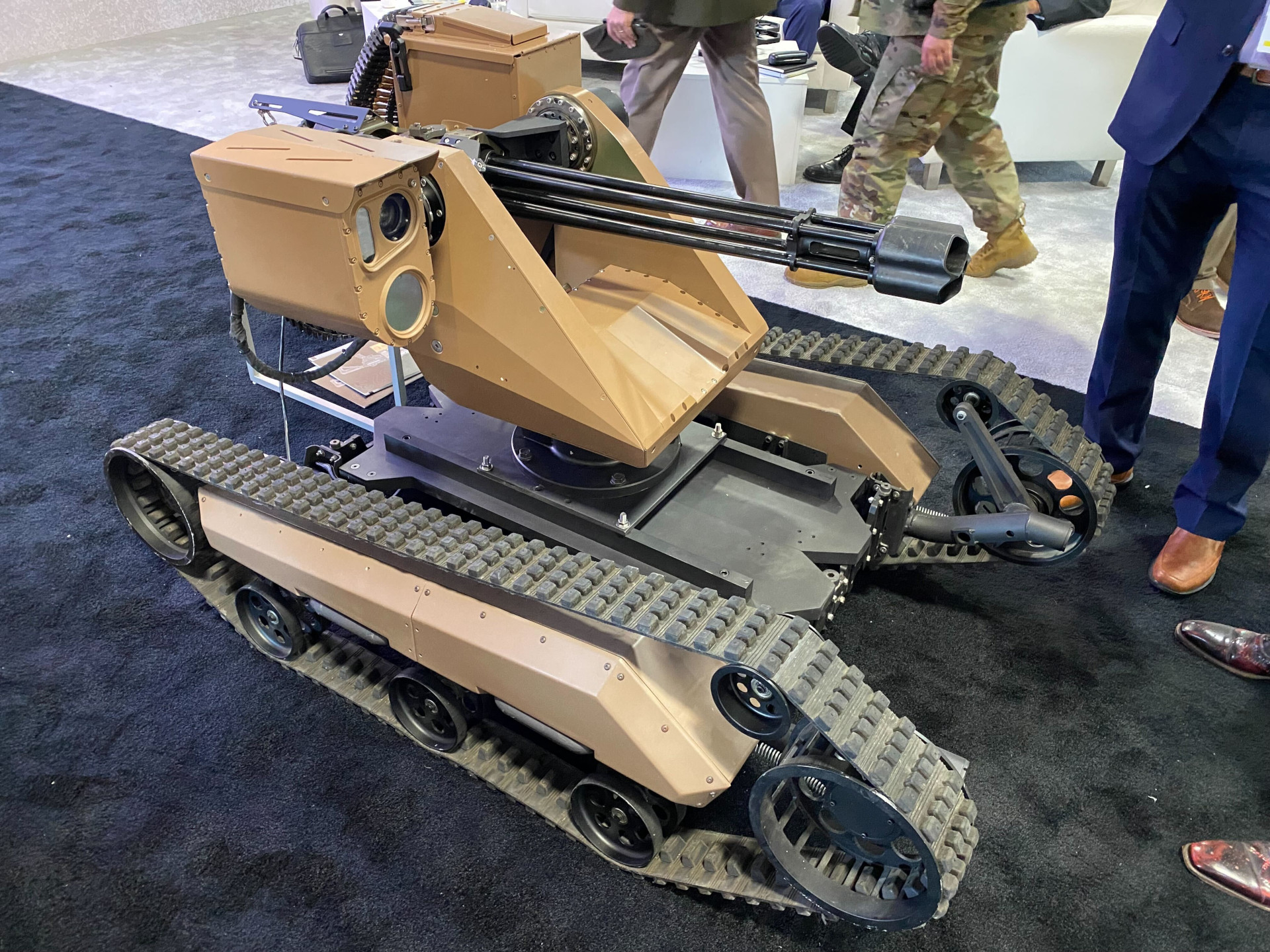
It also further underscores Sig Sauer’s interest in getting into the uncrewed space. The NG3 was mounted on the Mule using a remotely operated turret called Pitbull. Both Mule and Pitbull are products from a company called General Robotics, which Sig Sauer acquired last year.
While it remains to be seen if Sig Sauer’s pistol-armed quadcopters, or the NG3-armed Mule, see actual service, these are types of systems that look set to become more and more commonplace in military and security forces around the world.
Special thanks to Jamie Hunter for providing pictures from Sig Sauer’s booth at AUSA, as well as the comments from the company’s Jason St. John.
Contact the author: joe@thedrive.com
